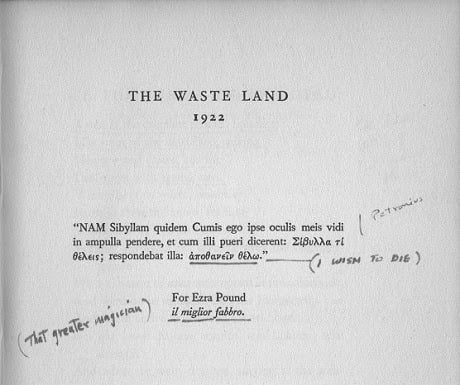
The Waste Land
T.S. Eliot

T.S. Eliot’s mind-bending, language-blending masterpiece, first published in the October 1922 issue of The Criterion and in book form two months later. A watershed text in twentieth-century poetry, the poem has been conceived as a retort to the stripped-down simplicity of the Imagists, though Eliot respected the movement’s innovations; in a 1953 lecture reprinted in To Criticize The Critic, he would claim:
The point de repère, usually and conveniently taken as the starting-point of modern poetry, is the group denominated ‘imagists’ in London about 1910.
Much of the power of The Waste Land derives from the allusions and name-dropping peppered heavily throughout the poem, in a style often described as “fragmented” or collage-like. This kind of fragmentation, as variously practiced by Eliot, Ezra Pound, Marianne Moore, and others, was one of the defining features of Modernist poetry in English.
Inspired in part by James Joyce’s Ulysses, which evokes a day in the life of a Dublin man-about-town through an elaborate series of parallels with Homer’s Odyssey, Eliot wanted to write a poem structured around an even more timeless story: that of the vegetation deity, which dies and reincarnates according to the seasons and their associated fertility. Eliot applies this scheme to modern life, with “fertility” corresponding roughly to “sexual passion” or “lust for life.”
For more, check out the Notes on The Waste Land that Eliot himself provided. (But watch out: they contain a few red herrings…)